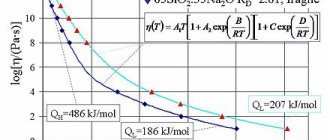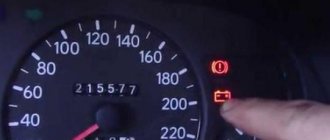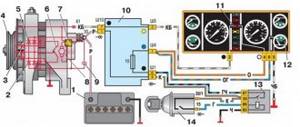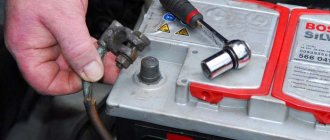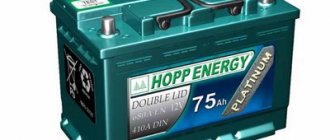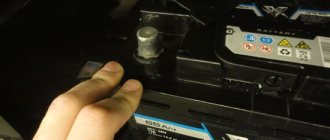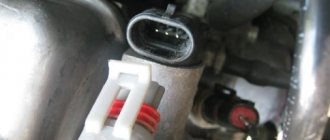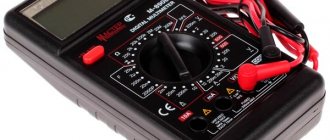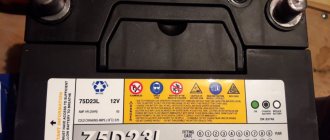Charging a car battery using special devices may be required after the car has been parked for a long time, as well as in cases where the generator cannot cope with this function. At retail outlets selling automobile spare parts, there is a large number of devices operating on a 220 V network, among which you can find the Orion Vympel 265 charger. The main technical characteristics of this device, as well as how to properly connect it to the battery, will be discussed in detail in this article.
Review of the Orion Vympel 265 device
The Orion Vympel 265 charger is fully automatic, so the only adjustment element is the variable resistor knob, which is installed on the front panel. Using it, you can change the current at the terminals from 0.4 to 7.0 Amperes. This parameter is indicated using an ammeter with a mechanical scale, which is located to the right of the adjustment element.
The front panel also contains red and green LEDs. The green indicator lights up immediately after connecting the device to the electrical network, the red indicator turns on only if the electronic charger unit has overheated.
The device is lightweight and has a very compact body. Thanks to the presence of a cavity designed to accommodate contact wires and a power cord, storing Vympel 265 is very convenient.
What to do if there is no charger
Situations often arise when the battery is low and there is no charger at hand. Many people try to adapt other devices for this - chargers from mobile phones, laptops, etc.
But such devices do not meet the required parameters. Thus, charging a phone at the output provides 5 V, and a laptop often provides 9 V, which is clearly not enough.
Even if you manage to find a 12 V charger, you won’t be able to use it on a car battery, because in order for it to accept a charge you need 14.2 V. Moreover, such chargers do not have current regulation.
In general, attempts to use chargers not intended for recharging a car battery can result in a variety of unpleasant consequences.
It is better to use the car itself, or rather its generator, to restore the charge.
To do this, you just need to start it by “lighting” or “towing.”
And then it is necessary to ensure the crankshaft speed at the level of 2500-3000 and minimize the number of switched on electrical consumers.
Under such conditions, in half an hour it will be possible to restore the charge quite well (but not completely).
Device Specifications
The technical characteristics of the Vympel NPP Orion 265 charger are as follows:
| Characteristic | Meaning |
| Voltage | 180-240 V |
| Current adjustment range | 0.4-7 Ampere |
| Output voltage in current stabilization mode | 0 to 15 V |
| Output voltage in voltage regulation mode | 14.9 – 15.1 V |
| Operating temperature range | from -10 to +40 C |
| Dimensions | 155x85x200 mm |
| Weight | 850 grams |
| Ammeter type | Switch |
This type of device operates from a regular household outlet.
Advantages and disadvantages
If you need to periodically charge the battery using a charger, choosing Orion products will be quite logical and correct.
Here are several main advantages:
- charging is carried out automatically;
- User intervention is not required during the operation of the memory;
- Many models provide current and voltage adjustment;
- a number of memory devices can be used as power supplies;
- capable of restoring sulfated batteries;
- the price is quite reasonable;
- there are no problems with purchasing in Russia, regardless of the city of residence.
But there are some drawbacks here. If we talk about outdated models, then the disadvantages here are conditional. Compared to new products, they are less effective. But the price is lower.
A really significant disadvantage would be the presence of a large number of counterfeits on the Russian market. Because of this, there are negative reviews about Orion products, most often due to the fact that the motorist did not purchase an original charger, but a counterfeit one.
Features of the device and for which batteries it is suitable
The minimum battery capacity that can be charged using the Vympel 265 device is 4.5 A/h. As a rule, such batteries are installed on mopeds, scooters and small motorcycles, the engines of which are started without the use of an electric starter.
The maximum capacity of batteries that can be effectively charged using this charger model is 70 A/h. Batteries of this capacity provide electricity to the on-board electrical network of a medium-power passenger car.
The charger of this model does not have to be used only for cars and motorcycles. Using such a device, you can easily restore batteries used in electric inverters or used as traction sources of electricity.
A special feature of the Vympel 265 device is the presence of protection against short circuits and polarity reversal. If at the time of connection you short-circuit the terminals or connect the positive conductor to the negative terminal of the battery, the device will automatically be switched to standby mode.
Does a new battery need to be charged?
It depends on where the battery was purchased. Normal modern sellers most often offer batteries ready for use. At the same time, before sale, all electrical parameters of the battery are carefully checked and they even offer a free check of the car’s charging system. On the other hand, problems may arise under other circumstances.
For some reason, after purchasing a car from a dealership, many new owners forget about the importance of checking the condition of its battery, which also needs to be recharged before full use, ensuring a level of 95-100%, and in some cases, restoring the electrolyte balance. Typically the process takes no more than four hours, which will increase the service life of the battery.
How to charge the battery using Vympel 265
To charge the battery using this charger model, follow the following instructions:
- Set the adjustment knob to the extreme left position.
- Connect the charger clamps to the battery terminals.
- Connect the power cord plug to a 220 V outlet.
- Turn the knob to the left until the required charging current appears on the indicator.
The maximum current for safe charging of the battery should not be more than 10% of the battery capacity. For example, to restore the charge of a battery with a capacity of 55 A/h, you need to set the current level to 5.5 A.
Types of memory
If you study the offered assortment of the Orion company, here you can see 2 main types of devices for charging batteries:
- chargers;
- starting-charging.
Starter chargers allow you to start the engine when the battery is very low or the temperature outside is low. If you live in a region with severe winters, when the temperature consistently drops below -10-15 degrees Celsius, you will hardly be able to do without a ROM.
There are several main features of ROM from Orion:
- This is a modern series of automatic devices that can independently control the charge level, change the start and charge mode;
- the designers provided for the use of high-frequency, pulsed energy conversion in the circuit, thereby reducing the weight and dimensions of the ROM;
- the devices have a forced ventilation system due to the operation of a built-in microfan;
- output characteristics allow you to charge the battery, regardless of their capacity and degree of discharge.
The second category is a series of chargers that are suitable for various car batteries, with a voltage of 12 or 24 V.
The model range is equipped with various levels of protection and has a built-in indication system. Due to this, you can monitor the progress of the charging procedure.
Reviews
Michael. Arkhangelsk The Vympel 265 charger does an excellent job of charging a car battery, but when the current is set to 4 amperes, the device makes a rather loud squeak.
Leonid. Kursk A very inexpensive and reliable device. More than a year has passed since the purchase, but the charger works without any complaints.
Dmitriy. Krasnodar A very simple device for charging the battery. The memory of this model is ideal for beginners.
When I got ready for work, in the morning the frost was not too bad, just 20 degrees, but Akum cranked the starter only a couple of times and showed no more signs of life. I didn’t force him anymore and went to the bus stop; luckily I got off earlier and wasn’t late for work. In the evening I went to the store to buy a charger, I was looking for something that would last more than once and was not expensive, the manager recommended Orion PW 265 so what kind of device is it:
The main purpose of this charger is to charge automobile and motorcycle 12 Volt batteries of any type and capacity in a fully automatic mode with the ability to manually adjust the charging current. The device controls and limits the voltage on the battery being charged, eliminating intense gas formation (boiling) and overcharging the battery. Therefore, the device can be used to charge modern maintenance-free batteries and does not require disconnecting the battery being charged from the vehicle’s on-board network. The device is intended for indoor use only and is resistant to high humidity. The charger can also be used as a DC source to power automotive equipment, power tools, halogen lamps and other devices and instruments. The charger is housed in a plastic case with louvers for ventilation. On the front panel there is a charging current regulator, a power LED and an ammeter scale. The power cord and output wires with clamps are stored in the rear compartment of the case.
When is it necessary to charge the battery?
The main indicator is the electrolyte, or rather its density. This indicator should be no lower than 1.25 g/cm3 and no higher than 1.29 g/cm3. It is measured by a special device - a hydrometer.
For certain climatic conditions, these figures need to be clarified.
Therefore, it is advisable that the device is always at hand, it is easy to use and no special training is required.
Below are situations when it is necessary to recharge the battery:
- when the battery is discharged after the car has been parked for a long time;
- during a long period of several attempts, but unsuccessfully starting the car, which led to the battery being discharged.
- due to other situations that led to the power supply being discharged or failing.
Join the conversation
Examples of boards. To protect the power part from overheating, a microfan in the NPP Orion model and an output current limiting circuit are used. Using such a device, you can easily restore batteries used in electric inverters or used as traction sources of electricity. An ammeter is used to indicate the flowing charging current.
The malfunction turned out to be simple, but the work done was not in vain. Well, everything was immediately clear, there was a short circuit. When normal temperature conditions are restored, the manual adjustment range is restored. To protect the power part from overheating, a microfan in the NPP Orion model and an output current limiting circuit are used. I had this resistance that the voltage was 15 V, to make it 16 V it was necessary to increase the rating by Ohm.
Charging from A to Z
If you use the car constantly and make long trips, then regular recharging is not necessary. But if the battery has not been used for a long time, it needs to be recharged at least once a month.
Peculiarities
As you know, Ampere and Volt are units of measurement of eclectic current.
When charging the battery, the following factors must be taken into account to monitor and charge correctly:
- The current should not be higher than 10% of the rated energy capacity of the battery. For example, if the battery capacity is 60 Ampere hour, then the current should not exceed 6 Ampere.
- The normal voltage at the charger terminals is 10% higher than the rated voltage of a fully charged battery. Let’s say that a fully charged battery has a terminal voltage of 12.6 Volts. Since 10% of this indicator is 1.26 Volts, it must be added to the nominal one and it turns out that the normal voltage at the charger terminals should be 13.86 Volts.
The battery can be quickly charged using high currents - from 20 Amperes to 30 Amperes. But such charging causes the battery to wear out quickly, so it is better not to use it.
When charging the gel battery, it is necessary to ensure that the voltage in the electrical network is not higher than 14.2 Volts.
These criteria should be taken into account to properly charge your car battery. Knowing what Ampere and Volt indicators should be in the electrical circuit when charging, you can start charging the battery. The video from VseInstruments.ru will tell you how to properly charge a car battery.
Preparatory work
Before charging, you should read the instructions, which describe how to properly charge your car battery. The charging circuit includes checking the battery charging: you need to make sure that it is completely discharged. It must be removed from the engine compartment and subjected to a thorough inspection.
The cause of discharge can be not only natural discharge, but also a violation of the integrity of the battery case. In this case, the electrolyte is poured out and no chemical reaction occurs. If inspection reveals a crack, then all the electrolyte has leaked out of the battery. Such a battery cannot be used in the electrical circuit of a car.
You can find out whether the battery is low thanks to the color indicator installed on the cover of its case. The indicator may have different colors, so as not to make a mistake, you need to study the diagram with explanations that is pasted near the indicator.
You can check the charging without removing it from the car using a conventional tester by measuring the voltage at the terminals of the device. A battery that is discharged will have lower voltage than normal.
Terminal voltage measurement
Before recharging a discharged battery, you should check the amount of electrolyte and its condition. This can be done without removing the battery through the filler plugs. If the electrolyte meets the standard, then it should be transparent, clean, free of impurities and completely cover the plates. If there is not enough electrolyte, then you need to add as much water as required according to the instructions.
In addition, you need to check the ventilation hole on the battery cover; this does not require removing it. It must be clean so that fumes can escape freely.
Charging process
It is important to remember during charging that the electrolyte evaporates, so it is better to charge the battery without removing it from the car in the garage or after removing it from the car, charge it in a non-residential area. It is also important to adhere to the correct connection diagram. If the charger is connected incorrectly, the fuses on the charger may fail.
You can charge the battery in two ways, with or without removal:
- With method 1, the voltage does not change during charging and is 14-16 Volts. The current strength changes. At first, the current is large and can be 25-30 Amperes. The current then decreases as the battery charges.
- The second method is more complicated. During charging, the voltage changes, so constant monitoring is required, but the current remains constant.
The charging circuit for a car battery using a constant voltage method is simple. To do this, you need to use the regulator to set how much current should be. It is equal to 10% of the nominal energy capacity of the battery. During charging, the current will decrease. You can determine that the battery is fully charged by looking at the ammeter needle: it should drop to o. If you set this amperage, a full recharge usually takes 10-13 hours.
Charging a car battery
It is more difficult to charge a device with the constant current method, you need to follow a certain pattern during charging that you should know. First, as in the first method, you need to set the current strength, for example, 6 Amperes, which is equal to 10% of the rated energy capacity of the battery for 60 Ampere hours. With this current, the battery is charged until the voltage value is 14 Volts.
The current must be halved, that is, to 3 Amperes, and charging continued at this current until the voltage reaches 15 Volts. Next, the current strength should be made two times less - 1.5 Amperes. How much you need to charge can be determined by the voltage level. If the voltage reading remains at the same level for more than an hour, this means that the battery is fully charged. Volts can be measured using a voltmeter.
If the charge is full, the engine should start easily at idle. This completes the charging of the unit.
Interesting from ESpec
Will seek.
Then I took a two-position button and soldered it into the fuse gap. Turn the knob to the left until the required charging current appears on the indicator. As a result, for 16 V it turned out to be 11.5 KOhm. The result of the malfunction is a low and unstable PWM operating frequency due to the capacitor.
After thinking and searching, we localize the place and find it. And the voltage is low. During the warranty period, the manufacturer repairs the product free of charge.
Using such a device, you can easily restore batteries used in electric inverters or used as traction sources of electricity. Connect the power plug to a socket with voltage V. It is not clear what the cause of the breakdown was. An ammeter is used to indicate the flowing charging current. More complex work related to disassembling the housing Z. Charging for car batteries. Protection against short circuit and reverse polarity. With your own hands
How often to charge your car battery
One type of battery maintenance is to recharge it from an external power source.
Changing operating conditions lead to the fact that the generator cannot restore the battery charge to 100%, but this can be done with a charger (charger).
The frequency of such battery maintenance directly depends on the degree of its wear and operating conditions.
For a new battery, it is enough to carry out CTC and recharge from the charger once a year before winter. But gradually the number of charges will have to be increased.
Ultimately, the battery will exhaust its resource completely and will have to be replaced.
How to check if the battery is charged
There are several ways to find out the charge.
- Check the color indicator. Most often this is a green “eye” in the body. If the indicator is green, the battery is charged, if black, the battery is discharged. The indicator will not show the exact state of charge;
- Measure with a multimeter. The multimeter must be set to measure voltage - voltmeter, set the scale to 20 V and connect the wires to the battery terminals. If the device shows a voltage of 12.7 V, the battery is charged, if the voltage drops to 12.1-12.5 V, it’s time to recharge, and if it drops to 11.7 V and below, it is very discharged;
- Measure with a load fork. The most accurate method, the one used by professionals. The device takes readings under load. Readings of 9.6-10 V are considered normal. If the voltage drops below 9 V, charging is necessary;
- Measure the density of the electrolyte using a hydrometer . The method is only suitable for serviced batteries. Normal density is 1.25 -1.27 g/cm;
- Use a charger with voltage measurement function.


